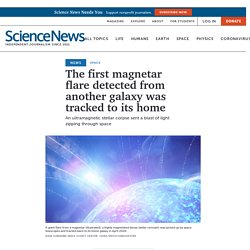

First magnetar flare detected from another galaxy tracked to its home. For the first time, astronomers have definitively spotted a flaring magnetar in another galaxy.

These ultra-magnetic stellar corpses were thought to be responsible for some of the highest-energy explosions in the nearby universe. But until this burst, no one could prove it, astronomers reported January 13 at the virtual meeting of the American Astronomical Society and in papers in Nature and Nature Astronomy. SpaceX will launch private citizens into orbit. SpaceX is planning to send up to four private citizens into space to take a trip around Earth sometime at the end of 2021 or in early 2022.

The spaceflight company announced an agreement on Tuesday with Space Adventures, a space tourism business that has helped seven different private citizens take trips to (and from) the International Space Station aboard Russia’s Soyuz rocket and spacecraft. There Could be Meteors Traveling at a Fraction of the Speed of Light When They Hit the Atmosphere. It’s no secret that planet Earth is occasionally greeted by rocks from space that either explode in our atmosphere or impact on the surface.

In addition, our planet regularly experiences meteor showers whenever its orbit causes it to pass through clouds of debris in the Solar System. However, it has also been determined that Earth is regularly bombarded by objects that are small enough to go unnoticed – about 1 mm or so in size. According to a new study by Harvard astronomers Amir Siraj and Prof. Abraham Loeb, it is possible that Earth’s atmosphere is bombarded by larger meteors – 1 mm to 10 cm (0.04 to 4 inches) – that are extremely fast.
These meteors, they argue, could be the result of nearby supernovae that cause particles to be accelerated to sub-relativistic or even relativistic speeds – several thousand times the speed of sound to a fraction of the speed of light. Earth to align with Mars, Moon in lunar occultation on Tuesday morning. LAS VEGAS (KSNV) – The Las Vegas Metropolitan Police Department said in a release that Friday night's protests on the Las Vegas Strip turned violent, resulting in 12 officers getting injured.

According to LVMPD, the protests began peacefully, with between 200 and 300 demonstrators gathered at the miracle mile shops. After several hours, police say a group of agitators started to rachet up tensions. RELATED | Hundreds protest on Las Vegas Strip demanding justice for George Floyd Police say they ordered the crowd to disperse. Nypost. One of the more interesting astronomy stories that came out at the tail end of 2019 was the bizarre behavior of the nearby star known as Betelgeuse.

It sits somewhere between 520 and 650 light-years from Earth, and that’s extremely close in the grand scheme of things, making its behavior of particular interest to us here on Earth. Months ago, scientists alerted us to the fact that Betelgeuse is getting dimmer. This massive star is currently a red supergiant, and the fact that it appeared to be dimming hinted at a number of possible outcomes, including a possible collapse and supernova explosion.
Now, with several more weeks of observations under their belt, researchers have discovered that Betelgeuse isn’t just dimming, it’s dimming in a very bizarre way. As Phil Plait of SYFY Wire reports, high-resolution images captured by the Very Large Telescope reveal that Betelgeuse is indeed dimming… but only part of it is actually changing in brightness. Image Source: ESO/M. This is the most violent object in the solar system. New images reveal that one of the strangest asteroids in the solar system is also the most covered in craters.

Pallas, at 318 miles (512 kilometers) in diameter, is the third-largest asteroid in the asteroid belt between Mars and Jupiter, accounting for about 7% of the region's mass. When Pallas was discovered in 1802, it was just the second asteroid ever found, and its discoverer, German astronomer Heinrich Wilhelm Matthäus Olbers, originally classified it as a planet. Pallas has long been known to follow a strange path through space. Breakthrough Listen releases 2 petabytes of data from SETI survey of Milky Way. The Breakthrough Listen Initiative today released data from the most comprehensive survey yet of radio emissions from the plane of the Milky Way Galaxy and the region around its central black hole, and it is inviting the public to search the data for signals from intelligent civilizations.

At a media briefing today in Seattle as part of the annual meeting of the American Association for the Advancement of Science (AAAS), Breakthrough Listen principal investigator Andrew Siemion of the University of California, Berkeley, announced the release of nearly 2 petabytes of data, the second data dump from the four-year old search for extraterrestrial intelligence (SETI). A petabyte of radio and optical telescope data was released last June, the largest release of SETI data in the history of the field. The data, most of it fresh from the telescope prior to detailed study from astronomers, comes from a survey of the radio spectrum between 1 and 12 gigahertz (GHz).
Earth transit zone survey. It Turns Out Rust Is… a Great Shield for Deadly Space Radiation. Rust to Riches Lifehack for future space commuters: Leaving your ship out in the rain could save your life.

That’s because new research suggests a layer of powdered rust is a particularly effective shield when it comes to blocking dangerous cosmic radiation — the kind that bombards astronauts and their equipment once they leave the safety of Earth’s atmosphere. Bucket Of Bolts Protecting astronauts from cosmic rays is one of the great challenges that needs to be solved before space agencies can send a crewed mission to Mars or beyond — that much exposure is simply too dangerous given current shielding technology.
But oxidized metal, especially gadolinium (III) oxide, blocks more radiation by weight than anything else out there, according to research published last month in the journal Radiation Physics and Chemistry. Light Armor. Earth's cousins: Upcoming missions to look for 'biosignatures' in exoplanet atmospheres. Scientists have discovered thousands of exoplanets, including dozens of terrestrial—or rocky—worlds in the habitable zones around their parent stars.

A promising approach to search for signs of life on these worlds is to probe exoplanet atmospheres for "biosignatures"—quirks in chemical composition that are telltale signs of life. For example, thanks to photosynthesis, our atmosphere is nearly 21% oxygen, a much higher level than expected given Earth's composition, orbit and parent star. Finding biosignatures is no straightforward task. Scientists use data about how exoplanet atmospheres interact with light from their parent star to learn about their atmospheres. But the information, or spectra, that they can gather using today's ground- and space-based telescopes is too limited to measure atmospheres directly or detect biosignatures. Deconstructing Schrödinger's cat. The paradox of Schrödinger's cat—the feline that is, famously, both alive and dead until its box is opened—is the most widely known example of a recurrent problem in quantum mechanics: its dynamics seem to predict that macroscopic objects (like cats) can, sometimes, exist simultaneously in more than one completely distinct state.

Many physicists have tried to solve this paradox over the years, but no approach has been universally accepted. Michael Guillen: Why is Pluto no longer a planet? The answer may surprise you (here's why it also must change) Make Pluto a planet again? Four4Four Science: Scientists want to restore Pluto's planet status; UAE eyes city on Mars, facial-recognition software could save lemurs, New Mexico's ancient matriarchy Pluto was a planet in good standing for seventy-six years when in 2006, out of the blue, it was demoted and booted from our solar system’s family of planets.
The stunning event – still hotly debated among astronomers – reveals more about astronomy’s messy subjectivity than Pluto’s stature. This is the most violent object in the solar system. Details pour in from New Horizons’ visit to a Kuiper Belt Object. Following its successful rendezvous with Pluto, the New Horizons spacecraft was sent on toward a smaller object out in the Kuiper Belt. As it shot past, the spacecraft captured images of a small world consisting of two very distinct lobes, with properties that scientists found a bit confusing.
But details would have to wait, as the combination of distance and power budget meant that transmitting much of New Horizons' data back to Earth was a slow process. The wait for that data is now over, as the high-resolution imagery is now available, and scientists have used it to try to better understand the formation and structure of what is now known as Arrokoth (named for the Powhatan word for "sky"). While the data doesn't answer every question we might have about Arrokoth, it does give us some very good ideas about how such a strange structure could have formed. Astronomers want public funds for intelligent life search. Image copyright Allen Observatory The head of one of the US's national observatories says the search for intelligent life elsewhere in the universe needs to be taken more seriously. Dr Anthony Beasley told the BBC that there should be greater government support for a field that has been shunned by government research funders for decades.
His backing for the search for extra-terrestrial intelligence (Seti) marks a sea change in attitudes to a field regarded until recently as fringe science. Astronomers Simulated How the Universe Would Look Without Dark Matter. Since the 1960s, there has been a general consensus among astronomers and cosmologists that the majority of the Universe is made up of an invisible, mysterious mass (known as Dark Matter). Europe's planet-hunting CHEOPS telescope beams down first image. It's better than expected. A planet-hunting probe has taken its first photos, and they're better than expected! CHEOPS (CHaracterising ExOplanets Satellite), a planet-hunting exoplanet telescope from the European Space Agency (ESA), launched into space on Dec. 18, 2019, atop a Soyuz rocket from Guiana Space Center in French Guiana. After the successful launch, the telescope's cover opened on Jan. 29, 2020; the team behind the satellite waited with bated breath for the device to snap its first images, confirming that everything was working properly and nothing was damaged during launch.
Related: The Strangest Alien Planets (Gallery) The fastest way to heat certain materials may be to cool them first. To heat a slice of pizza, you probably wouldn’t consider first chilling it in the fridge. But a theoretical study suggests that cooling, as a first step before heating, may be the fastest way to warm up certain materials. Europe's planet-hunting CHEOPS telescope beams down first image. It's better than expected. Astronomers discover potential near earth objects. Powerful Radio Signal From Deep Space Appears to Be Repeating in a 16-Day Cycle. One of the defining characteristics of the mysterious deep-space signals we call fast radio bursts is that they are unpredictable. They belch out across the cosmos without rhyme or reason, with no discernible pattern, making them incredibly hard to study. Now, for the first time, astronomers have found a fast radio burst (FRB) that repeats on a regular cycle.
Every 16.35 days, the signal named FRB 180916.J0158+65 follows a similar pattern. Rare monster galaxy grew rapidly 12 billion years ago … then suddenly died. SpaceX wins contract to launch NASA’s PACE Earth science mission. SpaceX has won an $80 million contract to launch a NASA environmental research satellite aboard a Falcon 9 rocket from Cape Canaveral in late 2022 to collect data on ocean ecosystems and clouds, a mission that the Trump administration wished to cancel.
The White House proposed terminating the Plankton, Aerosol, Cloud and ocean Ecosystem, or PACE, mission — and other Earth science projects — in the Trump administration’s first three budget proposals. But Congress restored funding on all three occasions, including in the fiscal year 2020 budget passed by lawmakers and signed into law by President Trump in December.
One of the brightest stars in the sky is dimming. Could it be on the verge of a supernova? Astronomers discover unusual monster galaxy in the very early universe. An international team of astronomers led by scientists at the University of California, Riverside, has found an unusual monster galaxy that existed about 12 billion years ago, when the universe was only 1.8 billion years old. Dubbed XMM-2599, the galaxy formed stars at a high rate and then died. Why it suddenly stopped forming stars is unclear. Images obtained of two stars in the process of a merger. We know two facts about our galaxy that are, in isolation, mundane. Anti-solar panel can generate electricity at night, researchers say. How many stars eventually collide as black holes? The universe has a budget for that. Since the breakthrough in gravitational wave astronomy back in 2015, scientists have been able to detect more than a dozen pairs of closely located black holes—known as binary black holes—by their collisions into each other due to gravity.
Glowing green 'dunes' in the sky mesmerized skygazers. They turned out to be a new kind of aurora. Eu.usatoday. New Research Explains How Solar Panels Could Soon Be Generating Power at Night. Israel's flag flies on the International Space Station. TechCrunch fait désormais partie dâVerizon Media. Mars looks lumpy in these wild NASA Curiosity rover images. Space-time is swirling around a dead star, proving Einstein right again. Mars’ water may have been packed with minerals and salt, possibly supporting life, study says.
Driving massive galaxy outflows with supermassive blackholes. Astronomers Discover 'Invisible' Stars So Dim That We Can't See Them at All. The five: large telescopes. Black holes shouldn't echo, but this one might. Score 1 for Stephen Hawking? NASA slowly drains the oceans in an incredible animation, revealing hidden underwater mountain ranges and ancient land bridges. Ask Ethan: Why Can't The Large Hadron Collider Put More Energy Into Its Particles? Incredible NASA visualizations reveal universe as you have never seen it before. The Age of Interstellar Visitors. White dwarf causes strange relativity effect called frame dragging. NASA unveils 16 payloads that private lunar landers will take to the moon. Aurora chasers discovered and filmed a new type of aurora that reaches across the sky like fingers. It's called 'the dunes.'
2020 January 30 - Two Custers and a Comet. Astronomers witness the dragging of space-time in stellar cosmic dance. Glowing green 'dunes' in the sky mesmerized skygazers. They turned out to be a new kind of aurora. Launches 60 new Starlink satellites, sticks rocket landing at sea. ‘Meteor’ reports in L.A., San Diego flood social media. A proposed House bill is threatening to rework NASA’s Moon plans. NASA spacecraft breaks its own record with another swing by the sun. Today, NASA turns off a space telescope that peered into the extra cold Universe. SpaceX launches fourth batch of 60 Starlink satellites. Two satellites may collide in space over Pittsburgh tonight.
Report: Webb telescope has just a 12 percent chance of making launch date. Proposed House bill pushes NASA's crewed moon landing back to 2028. Voyager 2 just missed a spin in interstellar space. But it should be fine, NASA says. Researchers find evidence for metallic hydrogen at 425 gigapascals. How likely are space super-storms? The Spitzer Space Telescope's greatest exoplanet discoveries. NASA spacecraft breaks its own record with another swing by the sun. Glowing green 'dunes' in the sky mesmerized skygazers. They turned out to be a new kind of aurora.
Inside SpinLaunch, the Space Industry’s Best Kept Secret. How the Cosmic Microwave Background Reveals the Universe’s Contents. 'Curious and curiouser!' Meteorite chunk contains unexpected evidence of presolar grains. 2 satellites will narrowly avoid colliding at 32,800 mph over Pittsburgh on Wednesday. 2020 January 28 - Star Formation in the Tadpole Nebula. 2 satellites will narrowly avoid colliding at 32,800 mph over Pittsburgh on Wednesday.
The hottest exoplanet's atmosphere is melting before our eyes. The Brightest Supernova Ever Seen was Caused by a White Dwarf Spiraling into a Red Giant. Spitzer and the Afterlife of Broken Spacecraft. (10691321) Someone took that movie Walt Disney and Salvador Dali did together and set it to Pink Floyd because, how could you not? The Hottest Known Planet Continuously Melts its Own Atmosphere. TechCrunch fait désormais partie dâVerizon Media. New Theory Could Solve Universe’s Biggest Paradox. Physicists argue ancient life might have escaped Earth and journeyed to alien stars. Telescope captures most detailed pictures yet of the sun. Speeding Satellites On Collision Course Above Pittsburgh Do Not Hit – CBS Pittsburgh. How the Cosmic Microwave Background Reveals the Universe’s Contents. SpaceX is launching 'dark satellites' to stop its Starlink project from wreaking havoc with astronomical research. Astronomers are skeptical.
Why planets have size limits. Black holes shouldn't echo, but this one might. Score 1 for Stephen Hawking? Gravity: We might have been getting it wrong this whole time. Astronomers Have Caught a Rare And Massive 'Accretion Burst' in Our Galaxy. A burst of gravitational waves hit our planet. Astronomers have no clue where it's from. Earth Climate Models Bring Exoplanet To Life. -astronauts-repair-space-station-antimatter-detector. DARPA scraps XS-1 military space plane project after Boeing drops out. Russia's Mayak satellite: crowd-funded cosmic pest or welcome nightly visitor? Russia launches non-terrifying satellite that focuses Sun's solar rays onto Earth.
Mars Rover Is Frozen in Place Following Software Error. -junk-removal-terminator-tape-satellite-test. Betelgeuse Is the Most Intriguing Star in the Galaxy. House introduces NASA authorization bill that emphasizes Mars over moon. Astronomers Have Caught a 'Vampire' Star in The Act of Draining Its Companion. YouTube. Ask Ethan: How Can We See 46.1 Billion Light-Years Away In A 13.8 Billion Year Old Universe? This 'Vampire Star' Is Feeding on Its Companion to Create 'Super-Outburst'